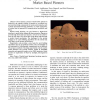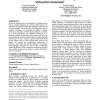527 search results - page 62 / 106 » Design beyond human abilities |
CHI
2010
ACM
14 years 3 months ago
2010
ACM
Although clinic environments are a primary location for exchanging information with clinicians, patients experience these spaces as harsh environments to access, use, exchange, an...
ICRA
2005
IEEE
14 years 2 months ago
2005
IEEE
— Direct human control of multi-robot systems is limited by the cognitive ability of humans to coordinate numerous interacting components. In remote environments, such as those e...
ATAL
2005
Springer
14 years 2 months ago
2005
Springer
In the past emotions have been dismissed as a distraction to the logical, scientific thought process. More recently however, the importance of emotion in human-like intelligence a...
VCIP
2003
13 years 10 months ago
2003
This paper presents a visual color image quality metric assessment with full reference image. The metric is highly based on human visual system properties in order to get the best...
TIP
2008
13 years 8 months ago
2008
The implicit framework of the level-set method has several advantages when tracking propagating fronts. Indeed, the evolving contour is embedded in a higher dimensional level-set f...


